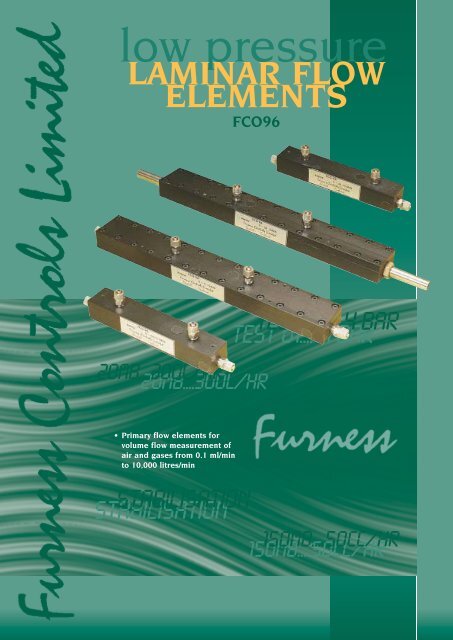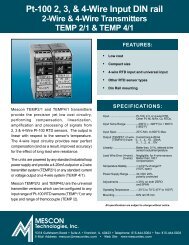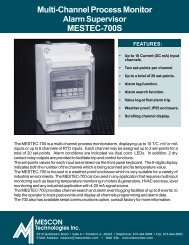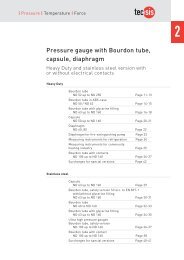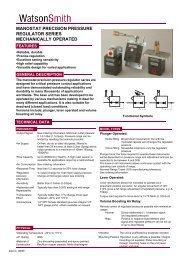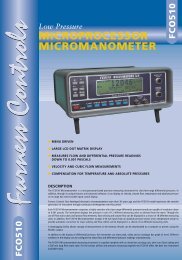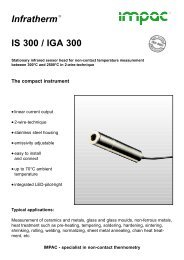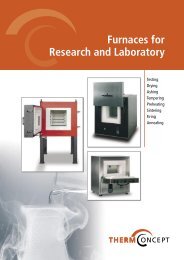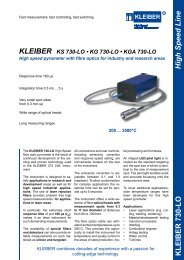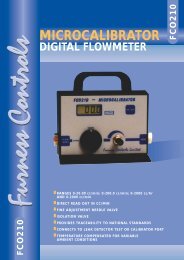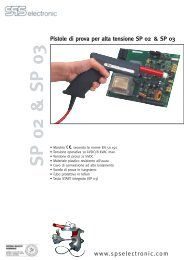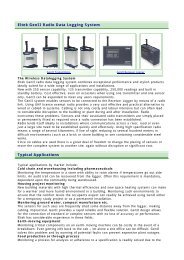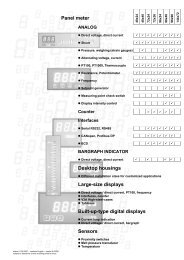Furness FCO096 Leaflet - Delta Strumenti S.r.l.
Furness FCO096 Leaflet - Delta Strumenti S.r.l.
Furness FCO096 Leaflet - Delta Strumenti S.r.l.
You also want an ePaper? Increase the reach of your titles
YUMPU automatically turns print PDFs into web optimized ePapers that Google loves.
low pressure<br />
LAMINAR FLOW<br />
ELEMENTS<br />
FCO96<br />
20MB....300L/HR<br />
20MB....300L/HR<br />
TEST 01.... 4 BAR<br />
TEST 01.... 4 BAR<br />
•Primary flow elements for<br />
volume flow measurement of<br />
air and gases from 0.1 ml/min<br />
to 10,000 litres/min<br />
STABILISATION<br />
STABILISATION<br />
150MB....50CC/HR<br />
150MB....50CC/HR
Description<br />
The FCO96 series of Laminar Flow Elements<br />
(LFE’s) is a family of primary flow devices for the<br />
measurement of low volume air and gas flows<br />
from 0.1 ml/min to 10,000 litres/min. The FCO96<br />
LFE’s provide the ability to measure accurately<br />
and repeatably the low flows encountered in<br />
sampling systems, injectors and respiration<br />
applications.<br />
Flow measurements are often made by orifice<br />
plate, venturi or nozzle, where the differential<br />
pressure generated is related to flow through<br />
square law. The FCO96 Laminar Flow Elements<br />
have a linear relationship between differential<br />
pressure and flow which allows a much higher<br />
turndown to be achieved. Laminar flow<br />
conditions are achieved below a Reynolds<br />
number of 2000.<br />
The FCO96 Laminar Flow Elements generate<br />
a low differential pressure, offering little<br />
restriction to flow. Typical is a value of 10<br />
mmH 2 0 for full flow rate. Suitable measuring<br />
instruments are the <strong>Furness</strong> Controls range of<br />
micromanometers, transducers, transmitters<br />
and indicators.<br />
Applications<br />
• Core Porosity Testing<br />
• Vacuum Cleaner Testing<br />
• Injector Testing<br />
• Airline Metering<br />
• Gas Burner Setting<br />
• Respiration Monitoring<br />
• Catalytic Converter Testing<br />
• Air Filtration Control<br />
Theory<br />
Laminar flow conditions are present in a gas<br />
when the Reynolds number is below the critical<br />
figure of 2000. Above this figure the condition of<br />
fluid is considered to be turbulent. Below this<br />
figure the pressure difference over a given<br />
length is linear with flow rate.<br />
<strong>Furness</strong> Controls’ FCO96 Laminar Flow Orifices<br />
are designed around a Reynolds number of 500,<br />
putting them well within the linear flow range.<br />
Each device is engineered to provide flow<br />
expansion/reduction chambers at the<br />
inlet/outlet, so that the flow is linear to<br />
differential pressure at the measuring points.<br />
Installations<br />
The FCO96 Laminar Flow Elements are<br />
provided with compression plain or flange<br />
fittings for the end flow connections. The actual<br />
sizes vary according to range, and are detailed<br />
under ‘Dimensions’. The differential pressure<br />
connections are generally suitable for 6 x 4mm<br />
tubing.<br />
The orientation of the Laminar Flow Element<br />
is not important and does not affect the<br />
calibration. It should be ensured that the<br />
incoming and outgoing flow tube connections<br />
are maintained at the same internal diameter<br />
for at least ten diameters run, otherwise<br />
interference with the flow pattern could result<br />
in calibration shift. It should be noted that the<br />
air or gas should be clean, build-up of dirt on<br />
the contact surfaces will result in a gradual<br />
deterioration of performance.<br />
The pipe connections must be leak-tight.<br />
Relative Viscosity Of Gases<br />
FCO96 series of Laminar Flow Elements are<br />
calibrated for air and gas of a given iscosity.<br />
They can be re-calibrated for different gases<br />
using the relative viscosities in the table below.<br />
Increasing the density may result in a non-linear<br />
relationship.<br />
Laminar Flow Elements can be corrected for<br />
viscosity of different gases using the formula<br />
shown below.<br />
Volume of Air<br />
Volume of Gas =<br />
Relative Viscosity<br />
Models and Ranges<br />
MODEL RANGE NOMINAL DP<br />
FCO96-20 C: 0 TO 20 ML/MIN 5 TO 10 MMH 2 O<br />
FCO96-200 C: 0 TO 200 ML/MIN 5 TO 10 MMH 2 O<br />
FCO96-2 L: 0 TO 2 L/MIN 5 TO 10 MMH 2 O<br />
FCO96-5 L: 0 TO 5 L/MIN 5 TO 10 MMH 2 O<br />
FCO96-20 L: 0 TO 20 L/MIN 5 TO 10 MMH 2 O<br />
FCO96-30 L: 0 TO 30 L/MIN 5 TO 10 MMH 2 O<br />
FCO96-200 L: 0 TO 200 L/MIN 5 TO 10 MMH 2 O<br />
FCO96-2000 L: 0 TO 2,000 L/MIN 5 TO 10 MMH 2 O<br />
FCO96-10000 L: 0 TO 10,000 L/MIN 5 TO 10 MMH 2 O<br />
Specifications<br />
PRINCIPLE<br />
RESOLUTION<br />
ACCURACY<br />
STATIC PRESSURE<br />
TRANSDUCERS<br />
& READOUTS<br />
GAS TYPES<br />
MATERIAL OF<br />
CONSTRUCTION<br />
VOLUME FLOW PRIMARY FLOW<br />
ELEMENTS USING LAMINAR FLOW<br />
BASED ON REYNOLDS NUMBERS<br />
BELOW 500<br />
ACCORDING TO DP INSTRUMENT USED<br />


